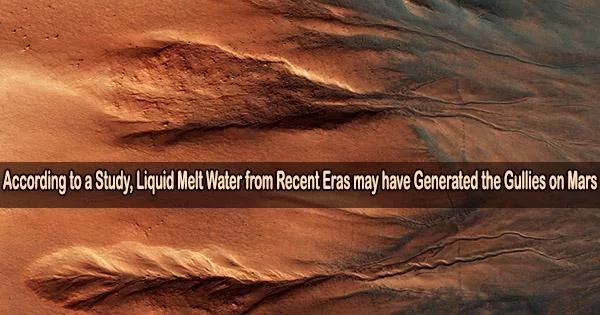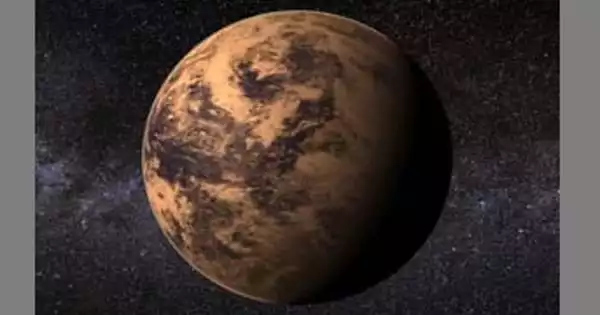New information from a study performed by Brown University researchers sheds light on the possibility that the ravine-like channels that cut down the edges of impact craters on Mars recently formed as a result of water from glaciers melting.
The research, which was presented in Science, focuses on gullies that have been formed on Mars that hauntingly resemble gullies that have been formed on Earth in the Dry Valleys of Antarctica as a result of water erosion from melting glaciers.
The scientists created a model that mimics a sweet spot for when conditions on Mars allow the planet to warm beyond freezing temperatures, resulting in times of liquid water on Mars when ice on and beneath the surface melts. The researchers included Brown University planetary scientist Jim Head in this effort.
The researchers discovered that the atmosphere on Mars becomes dense enough for brief bouts of melting to take place at certain places when the planet tilts on its axis by 35 degrees. When the gullies in the Terra Sirenum region of Mars are thought to have expanded quickly from high elevation points, a behavior that cannot be explained without the occassional presence of water, the researchers compared the data from their model to periods in the planet’s history.
“We know from a lot of our research and other people’s research that early on in Mars history, there was running water on the surface with valley networks and lakes,” said Head, a professor of geological sciences at Brown. “But about 3 billion years ago, all of that liquid water was lost, and Mars became what we call a hyper-arid or polar desert. We show here that even after that and in the recent past, when Mars’ axis tilts to 35 degrees, it heats up sufficiently to melt snow and ice, bringing liquid water back until temperatures drop and it freezes again.”
Everybody’s always looking for environments that could be conducive to not just the formation of life but the preservation and continuation of it. Any microorganism that might have evolved in early Mars is going to be in places where they can be comfortable in ice and then also comfortable or prosperous in liquid water. In the frigid Antarctic environment, for example, the few organisms that exist often occur in stasis, waiting for water.
Jim Head
The results fill in some of the gaps on how these gullies arose, including their height at their beginning, the severity of their erosion, and their length along the crater walls.
Previous theories suggest Martian gullies were carved by carbon dioxide frost, which evaporates from soil, causing rock and rubble to slide down slopes. Because of the distance the gullies traveled down the slopes and how worn they seemed, many experts theorized that meltwater from glaciers had to be involved due to the height of the gullies.
Since it vanished so long ago, it has been challenging to demonstrate that liquid water could have existed on Mars. Typically, temperatures on Mars stay about 70 degrees below freezing.
The results from the new study suggest that gully formation was driven by periods of melting ice and by CO2 frost evaporation in other parts of the year. The most recent episode, according to the experts, occurred roughly 630,000 years ago. This has probably happened numerous times over the past several million years.
They say that if ice was present at gully locations in the areas they looked at when Mars’ axis tilted to about 35 degrees, the conditions would have been right for the ice to melt because temperatures rose above 273° Kelvin, equivalent to about 32° Fahrenheit.
“Our study shows that the global distribution of gullies is better explained by liquid water over the last million years,” said Jay Dickson, the study’s lead author and a former researcher at Brown who’s now at California Institute of Technology. “Water explains the elevation distribution of gullies in ways that CO2 cannot. This means that Mars has been able to create liquid water in enough volume to erode channels within the last million years, which is very recent on the scale of Mars geologic history.”
The researchers were sure that the meltwater theory was valid since they had observed similar patterns personally in Antarctica, despite the fact that experts had concerns about meltwater’s feasibility and had never been able to predict the ideal conditions on Mars for ice to melt. In spite of the freezing conditions, the sun is able to heat the ice there just enough to cause melting and gully action.
The team’s earlier investigation on Martian gullies, which they began decades earlier, is continued in the latest paper. According to a 2015 study, for instance, if Mars rotated on its axis far enough in the past, water might have been present on Mars and could have formed gullies. The results prompted them to create a model of that tilt and compare it to where and how high gullies have grown.
The paper raises anew the fundamental question of whether life could exist on Mars. This is because life, as it’s known on Earth, goes hand in hand with the presence of liquid water. Mars will eventually tilt to 35 degrees again, the researchers said.
“Could there be a bridge, if you will, between the early warm and wet Mars and the Mars that we see today in terms of liquid water?” Head said. “Everybody’s always looking for environments that could be conducive to not just the formation of life but the preservation and continuation of it. Any microorganism that might have evolved in early Mars is going to be in places where they can be comfortable in ice and then also comfortable or prosperous in liquid water. In the frigid Antarctic environment, for example, the few organisms that exist often occur in stasis, waiting for water.”
The study also highlights the significance of these gullies as prospective destinations for future Mars exploration missions.
















